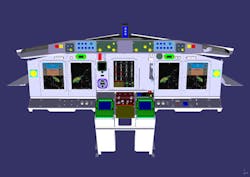From analog to digital: Boeing to modernize avionics, flight deck on U.S. Air Force and NATO E-3 707 AWACS aircraft
SEATTLE, 24 May 2012. Avionics engineers at The Boeing Company [NYSE:BA] will design a modernized flight deck and avionics suite for the U.S. Air Force and NATO E-3 707 Airborne Warning and Control System (AWACS) aircraft fleet. Rockwell Collins, Telephonics, Thales, EMS, and Raytheon are also contributing technologies to the upgrade.
The work falls under a $368 million engineering, manufacturing, and development (EMD) contract from the Electronic Systems Center at Hanscom Air Force Base, Mass. It marks the second phase of a cooperative program between the U.S. Air Force and NATO; the initial phase, which included subsystem requirements reviews, was completed in March.
Under the EMD contract, Boeing staff will integrate new and existing avionics and communications systems; develop a design to install the new equipment; upgrade one aircraft for each AWACS fleet; flight-test the new systems; develop logistics support data; and train flight crews and maintenance personnel.
Rockwell Collins will supply the flight management system suite, including glass displays and air-data and flight-management computers. Other suppliers include Telephonics of New York, Thales of Belgium, EMS of Canada, and Raytheon of Maryland. The upgraded flight deck will feature five main glass displays, providing the pilot and co-pilot with customizable engine, navigation, and radar data and enabling a reduction in the flight deck crew, from four to three.
"This move from analog systems to a digital flight deck will enable the U.S. and NATO AWACS fleets to meet current and identified future air traffic management requirements for flying in worldwide airspace," explains Jon Hunsberger, AWACS program manager for Boeing. "They also provide growth capability for any future requirements and solve the problem of diminishing manufacturing sources for flight avionics."
Installation is scheduled to begin on the NATO AWACS aircraft at a Boeing facility in Seattle during the third quarter of 2013. Modification of the U.S. AWACS begins in 2014. Both will be completed by the end of 2015. Production contracts for the remaining aircraft in the fleets will be awarded later.
